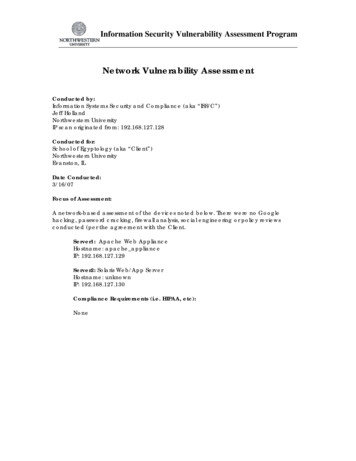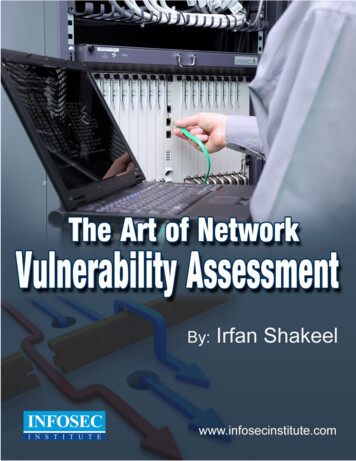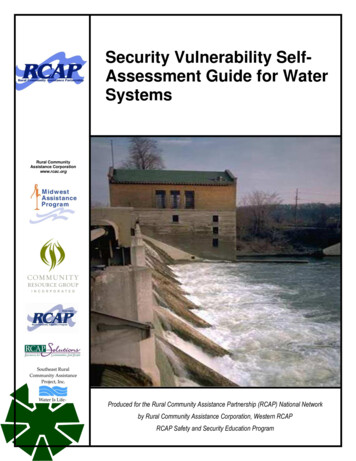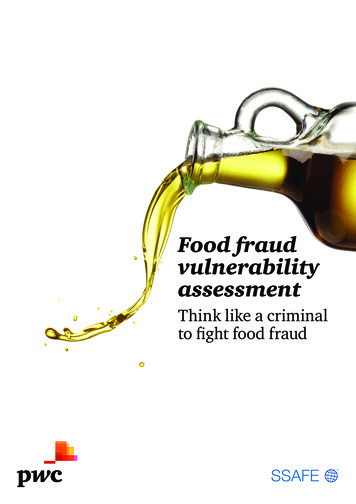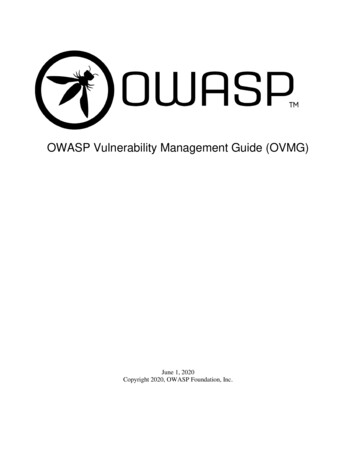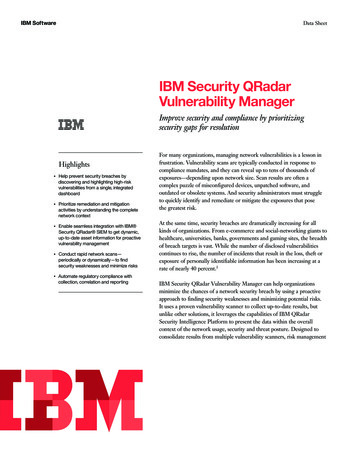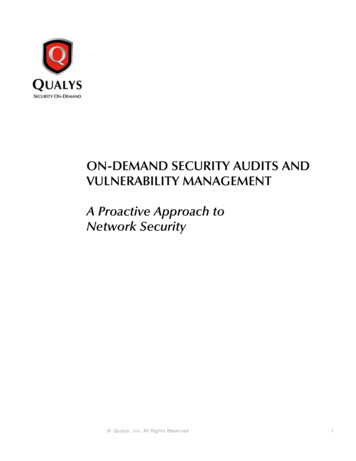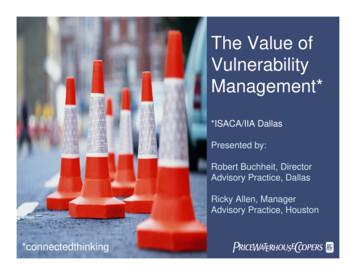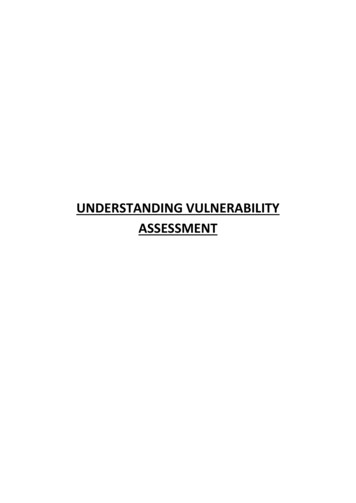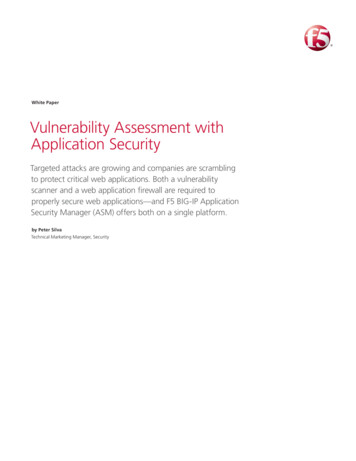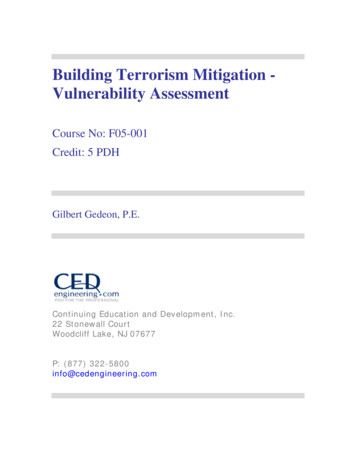
Transcription
Building Terrorism Mitigation Vulnerability AssessmentCourse No: F05-001Credit: 5 PDHGilbert Gedeon, P.E.Continuing Education and Development, Inc.22 Stonewall CourtWoodcliff Lake, NJ 07677P: (877) 322-5800info@cedengineering.com
ASSET VALUE, THREAT/HAZARD, VULNERABILITY, AND RISK1Mitigating the threat of terrorist attacks against highoccupancy buildings is a challenging task. It is difficult to predict how, why, and when terroristsmay attack. Many factors must be considered in creating a safebuilding environment. This chapter presents several methodologies for architects and engineers to quantify risk and to identifythe most effective mitigation measures to achieve a desired levelof protection against terrorist attacks at an acceptable cost. Themethodologies presented herein can be used for new buildingsduring the design process, as well as for existing buildings undergoing renovation. Sections 1.1 to 1.5 will discuss the assessmentprocess, asset value assessment, threat/hazard assessment, vulnerability assessment, risk assessment, and risk management to helparchitects and engineers identify the best and most cost-effectiveterrorism mitigation measures for each building’s unique securityneeds. Section 1.6 presents the Building Vulnerability AssessmentChecklist to support the assessment process.One of the primary objectives of this manual is to establish acommon framework of terminology and the transfer of designconcepts that have been in use by the United States (U.S.) Department of Defense (DoD), military services, the Department ofState (DOS), and the General Services Administration (GSA) tocommercial practice. The beginning point is to establish a basisfor design by identifying the threat or hazard to be designedagainst. Within the military services, intelligence community, andlaw enforcement, the term “threat” is typically used to describethe design criteria for terrorism or manmade disasters. Within theFederal Emergency Management Agency (FEMA) and other civilagencies, the term “hazard” is used in several different contexts.“Natural hazard” typically refers to a natural event such as a flood,wind, or seismic disaster. “Human-caused (or manmade) hazards”are “technological hazards” and “terrorism.” These are distinctfrom natural hazards primarily in that they originate from humanactivity. Furthermore, “technological hazards” are generallyASSET VALUE, THREAT/HAZARD, VULNERABILITY, AND RISK1-1
assumed to be accidental and that their consequences are unintended. For the sake of simplicity, this manual will use the terms“threat” and “hazard” when referring to terrorism and manmadedisasters, respectively.Figure 1-1Recent acts of terrorism (clockwise left toright, U.S. Pentagon, Arlington, VA; WorldTrade Center, New York, NY; MurrahU.S. AIR FORCEFEDERAL EMERGENCY MANAGEMENT AGENCYFEDERAL EMERGENCY MANAGEMENT AGENCYTerrorism and physical attacks on buildings have continued toincrease in the past decade. The geographical isolation of theUnited States is not a sufficient barrier to prevent an attack onU.S. cities and citizens. Figures 1-1 and 1-2 demonstrate the farreaching incidents and diverse natures and targets of recentterrorist attacks.Federal Building, Oklahoma City, OK)1-2ASSET VALUE, THREAT/HAZARD, VULNERABILITY, AND RISK
SOURCE: DEPARTMENT OF STATE PATTERNS OF GLOBAL TERRORISM 2002Figure 1-2Total facilities struck by international terrorist attacks in 1997-2002 and total facilitiesattacked in 2002Design of buildings to survive natural hazards is a concept thatis well understood by the design community. Many years of historical and quantitative data, and probabilities associated withthe cycle, duration, and magnitude of natural hazards exist. Conversely, design of buildings that can survive the threat and impactof a terrorist attack is based on qualitative factors that evaluateorganization requirements, recovery efforts and impacts, and lossASSET VALUE, THREAT/HAZARD, VULNERABILITY, AND RISK1-3
of personnel and infrastructure, but have no predictable periodof recurrence or damage probability. Terrorist attacks are oftencategorized as low probability, but potentially high consequence,events. Building designs must include physical security measuresas an integral part of the design process.This chapter presents selected methodologies to determine assetvalue, analyze the threat/hazard, and evaluate vulnerabilities tocomplete the risk assessment. These elements of informationbecome the input for determining relative levels of risk. Higherrisk hazards may require more complex mitigation measures toreduce risk. Mitigation measures are conceived by the designprofessional and are best incorporated into the building architecture, building systems, and operational parameters, withconsideration for life-cycle costs.In order to create a safe environment, many factors must be considered. Figure 1-3 depicts the assessment process presented inthis document to help identify the best and most cost-effectiveterrorism mitigation measures for a building’s own unique security needs. The first part of the assessment process identifies thevalue of a building’s assets (described in Section 1.1) that need tobe protected. The second step is to conduct a threat assessmentwherein the threat or hazard is identified, defined, and quantified (see Section 1.2). For terrorism, the threat is the aggressors(people or groups) that are known to exist and that have the capability and a history of using hostile actions, or that have expressedintentions for using hostile actions against potential targets, aswell as on whom there is current credible information on targeting activity (surveillance of potential targets) or indications ofpreparation for terrorist acts. The capabilities and histories of theaggressors include the tactics they have used to achieve their ends.After conducting a threat assessment, the next step is to conduct avulnerability assessment (see Section 1.3). A vulnerability assessmentevaluates the potential vulnerability of the critical assets against abroad range of identified threats/hazards. In and of itself, the vulnerability assessment provides a basis for determining mitigation1-4ASSET VALUE, THREAT/HAZARD, VULNERABILITY, AND RISK
Figure 1-3The assessment process modelmeasures for protection of the critical assets. The vulnerability assessment is the bridge in the methodology between threat/hazard,asset value, and the resultant level of risk.The next step of the process is the risk assessment (see Section 1.4).The risk assessment analyzes the threat, asset value, and vulnerabilityto ascertain the level of risk for each critical asset against each applicable threat. Inherent in this is the likelihood or probability ofthe threat occurring and the consequences of the occurrence. Thus,a very high likelihood of occurrence with very small consequencesmay require simple low cost mitigation measures, but a very lowlikelihood of occurrence with very grave consequences may requiremore costly and complex mitigation measures. The risk assessmentshould provide a relative risk profile. High-risk combinations of assets against associated threats, with identified vulnerability, allowprioritization of resources to implement mitigation measures.When starting the design process for any new building or the renovation of an existing one, various owner, statutory, and buildingASSET VALUE, THREAT/HAZARD, VULNERABILITY, AND RISK1-5
use inputs are required. These inputs must be integrated to ensure that mandatory building code requirements are met, thebuilding will meet the owner’s functional needs, and natural andmanmade hazards are mitigated to an acceptable level. In somecases, mitigation measures to enhance security may be in conflictwith other design intentions. The assessment process helps toensure an understanding of risk, so that it can be consciously addressed within the design process with available resources.For natural hazards (earthquakes, grassland and forest fires,floods, and winds) and building fire hazards (technological accidents), information is available in building codes, industrystandards, and FEMA guidelines. For manmade hazards, thesuggested course of action is less well defined. The United Stateshas not yet developed building standards similar to those of theUnited Kingdom, which has a greater history of contending withrepeated terrorism on its home soil. Helpful information maybe found in a strategic plan or a site master plan, or it may haveto be developed during initial design through interviews withbuilding owners, staff, occupants, utility companies, local law enforcement, and others.There are many tools and techniques available to the designerfor the development of new building designs, the renovation ofexisting buildings, and mitigation of vulnerabilities. Advancesin commercial satellite imagery, Geographic Information Systems (GIS) (see Figures 1-4 and 1-5), structural hardening, glassfragmentation films, physical security systems, and many otherbuilding related technologies provide the design professionalwith numerous tools to design buildings to better protect occupants from terrorist acts.Another challenge for the design team is to present appropriateinformation to the building owner/decision-maker in a mannerthat allows him or her to make a rational, informed decision. Ideally, design basis threats will be identified and agreed upon at theearliest stages of design (no later than preliminary design). Thereason for this is twofold. First, the designer must have a known1-6ASSET VALUE, THREAT/HAZARD, VULNERABILITY, AND RISK
Figure 1-4Satellite imagery/GIS toolquantity against which to design. Second, by considering allthreats/hazards (especially manmade threats) early in the design,there are potential synergies among mitigating actions. One mitigation strategy can be beneficial against more than one hazardfor little difference in cost. As an example, designing momentframe connections between floors and columns and reinforcingexterior walls can mitigate against winds, explosive blasts, andearthquakes. Thus, in order to design mitigation measures formanmade hazards, the designer must have some appreciation ofthe assessment of threat/hazard, asset value, vulnerability, andrisk to assist the building owner/decision-maker.ASSET VALUE, THREAT/HAZARD, VULNERABILITY, AND RISK1-7
Figure 1-5Satellite imagery/GIS toolBased on the methodologies discussed in this chapter, the assessment process follows a logical flow: Asset Value Identify criticality of assets Identify number of people in a building Threat/Hazard Assessment Identify each threat/hazard Define each threat/hazard Determine threat level for each threat/hazard Vulnerability Assessment Identify site and building systems design issues1-8ASSET VALUE, THREAT/HAZARD, VULNERABILITY, AND RISK
Evaluate design issues against type andlevel of threat Determine level of protection sought foreach mitigation measure against each threat Risk Assessment Likelihood of occurrence Impact of occurrence (loss of life,property, and function) Determine relative risk for each threatagainst each asset Select mitigation measures that have thegreatest benefit/cost for reducing riskDeter: The process of making the targetinaccessible or difficult to defeat with theweapon or tactic selected. It is usuallyaccomplished at the site perimeter using highlyvisible electronic security systems, fencing,barriers, lighting and security personnel; andin the building by securing access with locksand electronic monitoring devices.Detect: The process of using intelligencesharing and security services response to monitorand identify the threat before it penetrates thesite perimeter or building access points.Deny: The process of minimizing or delayingthe degree of site or building infrastructuredamage or loss of life or protecting assetsby designing or using infrastructure andequipment designed to withstand blast andchemical, biological, or radiological effects.The goal of the assessment process is toachieve the level of protection sought throughimplementation of mitigation measures in thebuilding design. These measures may reduceDevalue: The process of making the site orrisk by deterring, detecting, denying, or debuilding of little to no value or consequence,valuing the potential threat element prior to orfrom the terrorists’ perspective, such that anattack on the facility would not yield theirduring execution of an enemy attack. Mitigationdesired result.measures may also reduce risk of damage orinjury by providing an acceptable level of protection if the hazard does occur, which may alsoserve to further deter an aggressor. For example, the Murrah Federal Building in Oklahoma City became the target of an aggressorwhen he was deterred from attacking his primary target, the FederalBureau of Investigation (FBI) building, because it was too difficultto get the attack vehicle close to the FBI building. He was able topark immediately adjacent to the Murrah Federal Building and successfully target the office of the Bureau of Alcohol, Tobacco, andFirearms (ATF), which was located in the Murrah Federal Building.The remainder of this chapter describes the general concepts of assetvalue, threat/hazard, vulnerability, and risk assessments for manmadedisasters and presents several methodologies and techniques that canbe used by an organization in conducting these assessments.ASSET VALUE, THREAT/HAZARD, VULNERABILITY, AND RISK1-9
1.1ASSET VALUE ASSESSMENTThis section will describe how to perform an asset value assessment (the first step of the assessment process), to identify peopleand the asset value. To facilitate identifying people and the valueof a building’s assets, it is useful to conduct interviews of thepeople who are most familiar with them. Inputs from buildingowners, facility staff, and tenants, as well as any others who canhelp identify the most valuable assets, should be sought. In orderto conduct productive interviews, a list of areas to be coveredshould be generated and prioritized prior to the actual interviews. Thorough planning and research to generate relevantquestions will aid the process and yield better results.An asset is a resource of value requiring protection.1 An asset canbe tangible (e.g., tenants, buildings, facilities, equipment, activities,operations, and information) or intangible (e.g., processes or acompany’s reputation). In order to achieve the greatest risk reduction at the least cost, identifying and prioritizing a building’s criticalassets is a vital first step in the process to identify the best mitigationmeasures to improve its level of protection prior to a terrorist attack. Recognizing that people are a building’s most critical asset, theprocess described below will help identify and prioritize infrastructure where people are most at risk and require protection.Identifying a building’s critical assets is accomplished in a two-stepprocess:Step 1: Define and understand the building’s core functions andprocessesStep 2: Identify building infrastructure Critical components/assets Critical information systems and data Life safety systems and safe haven areas Security systemsAppendix B is a glossary of assessment and security terminology. Appendix C contains chemical,biological, and radiological terms.11-10ASSET VALUE, THREAT/HAZARD, VULNERABILITY, AND RISK
1.1.1Identifying Building Core FunctionsThe initial step of an asset value assessment is the determinationof core functions and processes necessary for the building to continue to operate or provide services after an attack. The reason foridentifying core functions/processes is to focus the design teamon what a building does, how it does it, and how various threatscan affect the building. This provides more discussion and resultsin a better understanding of asset value. Factors that should beconsidered include: What are the building’s primary services or outputs? What critical activities take place at the building? Who are the building’s occupants and visitors? What inputs from external organizations are required for abuilding’s success?1.1.2Identifying Building InfrastructureAfter the core functions and processes are identified, an evaluation of building infrastructure is the next step. To help identifyand value rank infrastructure, the following should be considered,keeping in mind that the most vital asset for every building is itspeople: Identify how many people may be injured or killed during aterrorist attack that directly affects the infrastructure. Identify what happens to building functions, services, oroccupant satisfaction if a specific asset is lost or degraded.(Can primary services continue?) Determine the impact on other organizational assets if thecomponent is lost or can not function. Determine if critical or sensitive information is stored orhandled at the building. Determine if backups exist for the building’s assets. Determine the availability of replacements.ASSET VALUE, THREAT/HAZARD, VULNERABILITY, AND RISK1-11
Determine the potential for injuries or deaths from anycatastrophic event at the building’s assets. Identify any critical building personnel whose loss woulddegrade, or seriously complicate the safety of buildingoccupants during an emergency. Determine if the building’s assets can be replaced and identifyreplacement costs if the building is lost. Identify the locations of key equipment. Determine the locations of personnel work areas and systems. Identify the locations of any personnel operating “outside” abuilding’s controlled areas. Determine, in detail, the physical locations of critical supportarchitectures: Communications and information technology (IT - the flowof critical information) Utilities (e.g., facility power, water, air conditioning, etc.) Lines of communication that provide access to externalresources and provide movement of people (e.g., road, rail,air transportation) Determine the location, availability, and readiness conditionof emergency response assets, and the state of training ofbuilding staff in their use.1.1.3Quantifying Asset ValueAfter a list of a building’s assets or resources of value requiringprotection have been identified, they should be assigned a value.Asset value is the degree of debilitating impact that would becaused by the incapacity or destruction of the building’s assets.There are many scales that can be used, each with advantagesand disadvantages. Because some people are used to workingwith linguistic scales, although many engineers and designersprefer numerical systems, this publication will use a combinationof a seven-level linguistic scale and a ten-point numerical scale as1-12ASSET VALUE, THREAT/HAZARD, VULNERABILITY, AND RISK
shown in Table 1-1. Obviously, the key asset for every building is itspeople (e.g., employees, visitors, etc.). They will always be assignedthe highest asset value as in the example below.Table 1-1: Asset Value ScaleAsset ValueVery High10High8-9Medium High7Medium5-6Medium Low4Low2-3Very Low1Very High – Loss or damage of the building’s assets would haveexceptionally grave consequences, such as extensive loss of life,widespread severe injuries, or total loss of primary services, coreprocesses, and functions.High – Loss or damage of the building’s assets would have graveconsequences, such as loss of life, severe injuries, loss of primaryservices, or major loss of core processes and functions for an extended period of time.Medium High – Loss or damage of the building’s assets wouldhave serious consequences, such as serious injuries or impairmentof core processes and functions for an extended period of time.Medium – Loss or damage of the building’s assets would havemoderate to serious consequences, such as injuries or impairmentof core functions and processes.Medium Low – Loss or damage of the building’s assets would havemoderate consequences
ability assessment, risk assessment, and risk management to help architects and engineers identify the best and most cost-effective terrorism mitigation measures for each building’s unique security needs. Section 1.6 presents the Building Vulnerability Assessment Checkl
